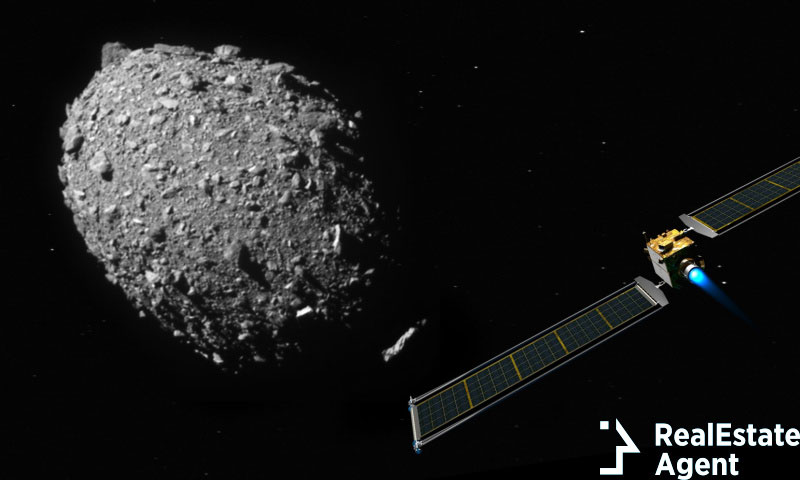There’s something deeply human about our love for celebration. Celebration is always about something out of the ordinary, a small event that makes us divert briefly from our usual course of doing things. It’s even better if you have someone to celebrate with, whether it’s a small group of people or a bigger collective. Or – in some cases – the whole world.
As we ended up living in the future lately, celebrating together with billions of people is something we are getting used to, but still a surprise every time, thanks to our friend, Google. The most popular search engine in the world has this nice habit of inviting people to celebrate with smart and fun animations dedicated to the actual special events happening. And they haven’t failed us this time either.
A historical event took place on September 26, and its effects continue to serve as important scientific research material for the times to come. NASA has completed the first-of-its-kind planetary defense technology demonstration mission and successfully impacted its asteroid target with the scope of diverting it from its course. The Double Asteroid Redirection Test, or more popularly just DART, targeted and collided with Dimorphos, a small asteroid moonlet orbiting his larger asteroid brother, Didymos, located at 6.8 million miles from Earth. On October 11, NASA confirmed that data collected in the past weeks shows that the kinetic impact successfully changed the asteroid’s orbit. So cheers, NASA, and cheers, DART Team!
Such an event as the Nasa DART mission can’t and shouldn’t go unnoticed, so if you want some memorable Google animation fun, try typing NASA DART in the search engine and see what happens! Hint: if your camera was on, it would record you looking like an engaged dog tilting its head, trying to understand something…
And things are worth understanding in this case, not only because it’s something groundbreaking in itself, but also because you will find lots of funny references to make you giggle while learning important stuff. At least, this is what happened to me. I will show you through the journey. Come on!
The NASA DART mission – why is it important?
The Nasa Dart mission accomplished something unprecedented, namely: the first full-blown asteroid deflection technology demonstration, if you’re following. Dart was aimed at the asteroid moonlet Dimorphos, with a body of 530 feet (160 meters) in diameter, orbiting a larger asteroid named Didymos, with a body of 2,560 feet (780 meters). The two form a cozy little binary asteroid system, with the smaller Dimorphos being the orbiting companion of the bigger Didymos. Dart flew 10 months in space before its impact on the 26th of September.
The mission confirms that Nasa can successfully execute a planned collision, more scientifically called “kinetic impact”. Analysis of the data collected since the collision confirmed that the mission also successfully altered the asteroid’s orbit. This was the scope of the mission: to test a method of defending Earth if the threat of an asteroid crashing into it would emerge.
So, this is a first in human history, and NASA Administrator Bill Nelson pinpointed its importance: “All of us have a responsibility to protect our home planet. After all, it’s the only one we have,” He added: “This mission shows that NASA is trying to be ready for whatever the universe throws at us. NASA has proven we are serious as a defender of the planet. This is a watershed moment for planetary defense and all of humanity, demonstrating commitment from NASA’s exceptional team and partners from around the world.”
The tech involved in the mission
You’re probably wondering by now, what did the star of the mission, the DART spacecraft itself, consist of? If you imagined something science-fictiony, I would ruin it for you: it looked like a box. A slightly bigger one, of 1,260 pounds (570 kilograms), but still in the shape of a box. The spacecraft was guided by DRACO (the Didymos Reconnaissance and Asteroid Camera for Optical navigation) and a navigation and control system working together with Small-body Maneuvering Autonomous Real Time Navigation (SMART Nav) algorithms. These were the systems helping DART identify and target the smaller Dimorphos between the two asteroids, and crashing it at about 14,000 miles (22,530 kilometers) per hour.
DART was also equipped with the Light Italian CubeSat for Imaging of Asteroids or LICIACube, a six-unit Cube Sat, provided by the Italian Space Agency. The LICIACube took images of the impact, sending back important data through direct communication with Earth. The LICIACube left the DART spacecraft 15 days prior to the impact to document the event and the aftermath. The asteroid released a cloud of matter (ejecta) after impact; the LICIACube is capturing images of it to provide a good base for the understanding of the collision. The images taken by LICIACube, together with those returned from DRACO, are providing important data for further research on the effectiveness of deflecting an asteroid.
LICIACube is the first autonomous Italian deep space mission and is equipped with two optical cameras. The cube did asteroidal study as well of the Didymos system during its flyby, from a distance of 56.7 km(35.2 miles).
Post-impact data
On the 11th of October, Nasa confirmed the success of the mission based on the analysis of data collected during the two weeks after the collision and released details on the Nasa Dart mission results. The DART investigation team confirmed that the spacecraft has succeeded in altering the asteroid’s orbit. This is a milestone in human history, marking the first time ever when humans were able to change the motion of an object in space intentionally and demonstrating the efficiency of asteroid deflection technology. For comparison, before DART’s impact, little asteroid Dimorphos needed 11 hours and 55 minutes to orbit around its big brother, Didymos. With data collected since the collision from observatories on the ground as well, scientists affirmed that measurements show that DART managed to shorten Dimorphos’s orbiting time by 32 minutes. The previous 11-hour 55-minute orbit is now down to 11 hours and 23 minutes.
And the investigation goes on, with the DART team collecting and analyzing data for more conclusions to draw. Nancy Chabot, the DART coordination lead from the Johns Hopkins Applied Physics Laboratory (APL) in Laurel, Maryland, said: “DART has given us some fascinating data about both asteroid properties and the effectiveness of a kinetic impactor as a planetary defense technology,”, and added that the work goes on: “The DART team is continuing to work on this rich dataset to fully understand this first planetary defense test of asteroid deflection.”
Lori Glaze, director of NASA’s Planetary Science Division at NASA Headquarters in Washington, commented on the importance of further information harvest: “As new data come in each day, astronomers will be able to better assess whether, and how, a mission like DART could be used in the future to help protect Earth from a collision with an asteroid if we ever discover one headed our way.”
Tails of dust
Images from Nasa’s Hubble Space Telescope recently revealed that two tails of dust were ejected from the Didymos-Dimorphos binary asteroid system instead of the expected one.
The Soar Telescope in Chile captured an image one week after the impact, where one tail of dust is already visible. The twin tail is a surprising development, although active asteroids and comets frequently act similarly.
The investigation team is working on understanding the phenomenon. The information collected in the past few weeks allowed the scientists to understand the evolution of the debris cloud over time. According to the observations, the ejecta behaved as expected and has expanded and faded over time. The twin tail is a surprising outcome; as of yet, there’s no clear explanation for why it appeared.
Pop-cultural references
With such groundbreaking events taking place, you just can’t resist letting a heavy dose of science fiction thoughts flood your existence. And, to make it even better, there’s a lot of humor to mix it with. On the official Nasa page, you can find their podcast and the related episode (Season Two, Episode 4: Deflecting Disaster) on the asteroid deflection technology demonstration (in text format, too), containing a few funny pop-cultural references related to the Nasa Dart mission. One of them, my favorite( since this was the first thing that came to my mind too when I heard about the mission), is the Futurama episode titled “A Big Piece of Garbage”. The episode is about the apocalyptic events earth is about to face because of a giant garbage ball approaching from space, which has been ejected from Earth in the year 2052 in a desperate attempt to get rid of the garbage problem. When I read about the asteroids and what kind of matter they are made up of, I found out that Dimorphos is a low-density rubble pile. My mind involuntarily read to me, “low-density rubbish pile”, and the funny thing is, it’s kind of correct. Here’s the snippet from the Futurama episode the Nasa podcast is quoting:
“Can’t we just shoot a missile at it?”
“We’ve simulated that on a supercomputer, but the ball is just too damn gooey. A missile would go right through it.”
They end up shooting another quickly made giant trash ball into the approaching one, successfully deflecting it and saving planet Earth.
Conferred as “A more modern idea for dealing with such threats”, another cool reference to be found is to a 1968 Star Trek TV episode, “The Paradise Syndrome”. And the quote goes:
Mr. Spock: “If we are not able to gain entry and activate the deflector mechanism within the next fifty minutes, this entire planet will be destroyed.”
Captain Kirk: “The key must be in these symbols. We’ve got to decipher them.”
Mr. Spock: “I’ve already have to some extent, Captain. They are musical notes.”
Captain Kirk: “You mean entry can be gained by playing certain notes…”
(fades to)
Captain Kirk: “More symbols. Can you read them?”
Mr. Spock: “I do have an excellent eye for musical notes Captain, they would seem to indicate that this series of relays, activated in their proper…”
Captain Kirk: “Spock, just press the right button.”
(laser sound)
Our mind, or reality?
Happenings of this significance inspire people to celebrate. To stop for a second on our usual course and be proud of what humans are capable of. Humor and laughter are part of celebration, and fascination with old shows predicting the future is not unprecedented like the Nasa Dart mission. If you think about is, the products of our imagination can possibly become someone else’s reality in the future.
To top it all, I will leave you with two Reddit jokes on the Nasa Dart mission, keeping at their core and making fun of the myth that the asteroid has now become a threat to another planet or civilization: user dragonknightkiller wrote in a comment: “That asteroid now collides with a planet where dinosaurs live.” or user Suspicious-Safety649 wrote: “Astronomers on planet Zonk be like “WTF! This wasn’t supposed to hit us in 800 years, and now it’s coming right at us”
But I really don’t want to spoil all of the funny stuff for you, so if you want more, you know where to look!














